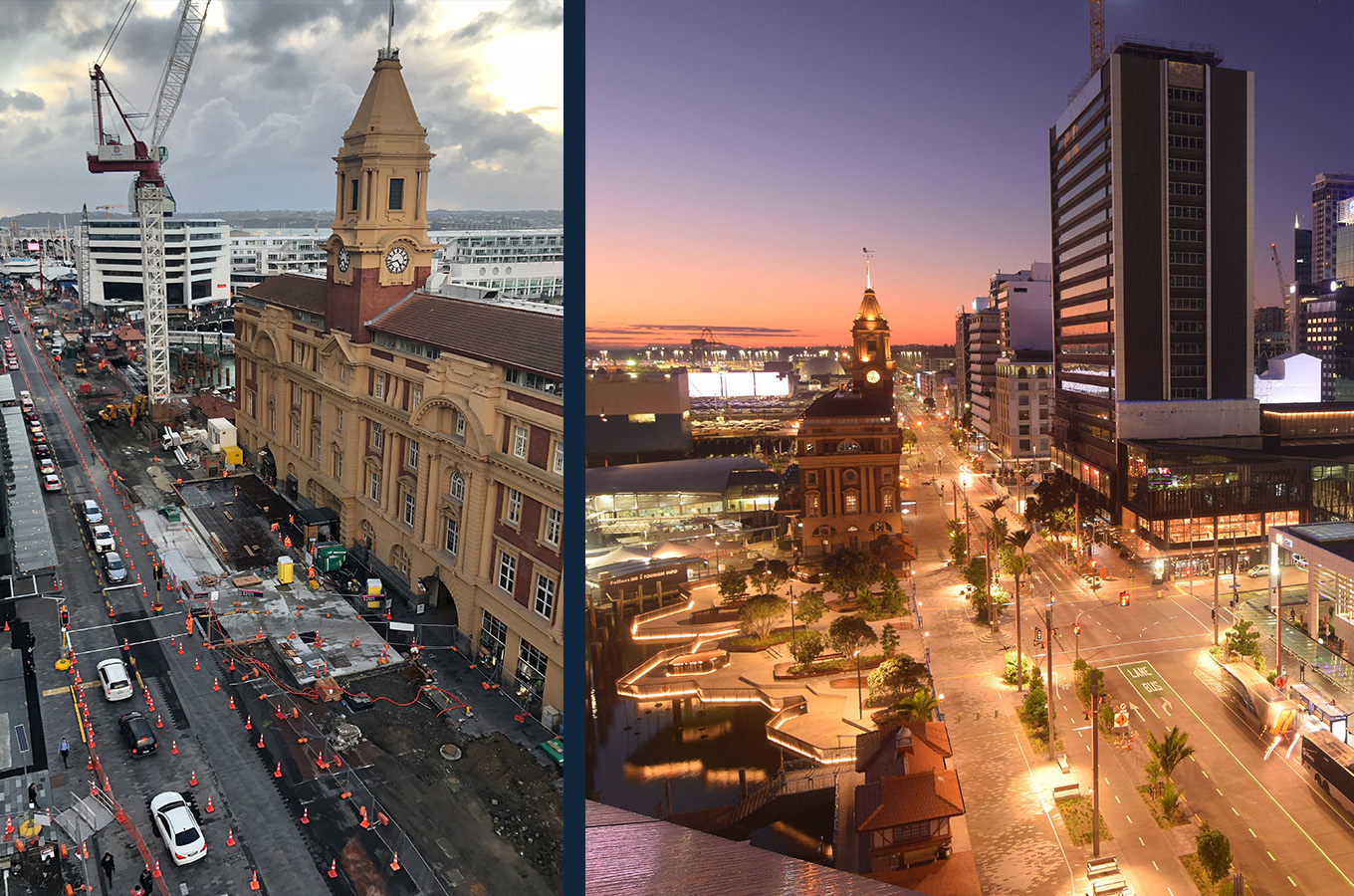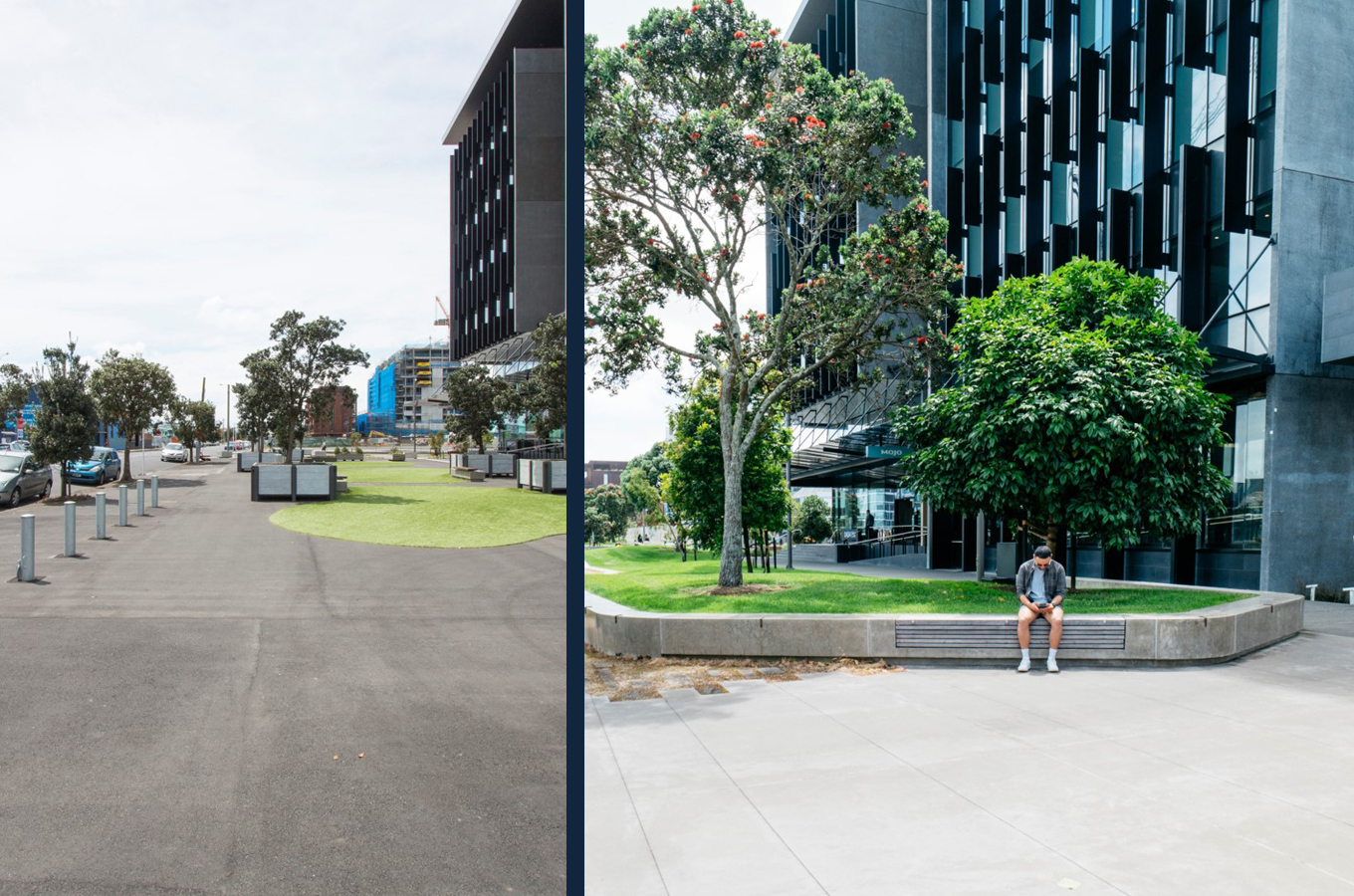With any transformation, it’s hard to imagine the beginning.
It’s easy to forget how our upgraded streets, lanes and squares in the city centre looked before the digging started. So we've compiled some pictures of the transition.
Have a look at how downtown looked before July 2021 when six projects were completed including a strengthened seawall. This was a $350million investment in a programme to transform our waterfront.
Te Wānanga upgrade
It’s difficult to believe downtown’s Te Wānanga wasn’t open little over three years ago. It’s an authentic and inviting space reaching out over the water next to Quay Street which was once a traffic thoroughfare, now a tree-lined boulevard.

Looking back further, some of us barely remember when the sparkling new Britomart Transport Centre (now known as Waitematā Station) opened in July 2003, or when the re-design of Wynyard Quarter began in 2011.
Britomart has become a thriving place where past and future blend, where renovated dockside warehouses stand alongside sleek new architecture, laneways buzz with people enjoying hospitality and shops flow into new streets and squares.
Similarly, Wynyard Quarter has evolved into a much-loved place, more than a decade into the planned 30-year redevelopment. The mix of new homes, shops and office development has enabled the growth of a strong, diverse and lively residential and business community, all while retaining the fishing and marine industries and inclusive public spaces.

Councillor Richard Hills says the City Rail Link and midtown regeneration programme are key catalysts of positive change in the city centre.
“They are tracking well and will deliver on the City Centre Masterplan we outlined in 2012 and refreshed in 2020, both receiving strong support from the public.
“Construction is continuing and it’s exciting that the finish-line for the CRL is in sight. When it’s operational in 2026, it will bring great relief for the 40,000 city centre residents, thousands of business owners and hundreds of thousands of workers, students and visitors who come to the city centre every week.
“By then, also, the streets, public spaces and lanes in the station neighbourhoods will be greener, safer and easier to walk and cycle around, enhancing the attractiveness of the city centre,” says Councillor Hills.
What’s coming up
The scale, complexity and momentum of positive change the Auckland Council group is leading in the city centre is substantial.
Read about the remarkable transformation we’ve seen in just five years.
Part of the ever-changing process of renewal in Auckland is the midtown regeneration programme which is at the heart of a significant shift in the way people travel into, out of, and through the city. Alongside the CRL it is expected to support a healthier and more sustainable city centre, and a vibrant arts and cultural heart of Auckland.
Midtown Regeneration
Jenny Larking, Auckland Council Head of City Centre Programmes reflects on how far the midtown regeneration has come.
“Momentum is continuing to build. The new shape of Victoria Street is visible as Te Hā Noa. The Queen Street to Elliott Street block on the northern side of the street has opened, and we’re making good progress on the southern side. Twenty new native trees, some fully mature, are coming into the street in the next few months,” Larking says.
Upgrades of Queen Street, Myers Park and upper Federal Street have all been completed as part of the midtown programme which is future-proofing infrastructure, bringing new energy to public spaces, and preparing the area for the opening of Te Waihorotiu Station.

Further north, construction has commenced on the plaza at Waitematā Station, and the upgrade of Tyler Street, to match the design of the revamped Galway Street.
This is the next key piece in the delivery of a high-quality network of public and shared spaces connecting the Britomart precinct with the Waitematā Station, Te Komititanga, Commercial Bay, Tyler and Galway Streets and Takutai Square. Read more about these projects.
Ever-changing cityscape
Patrick Reynolds who is deputy chair of the Auckland Council City Centre Advisory Panel and a director of Greater Auckland gives us his take.
“There is ongoing angst about construction disruption in the city centre. And fair enough: it’s very tough, CRL and other construction has been going on for a very long time.
“The good news is we are close to a significant end – not the end, of course, for a city is never finished. A city is an ever-changing process, more like a garden. As with a garden, periodically cities require a major overhaul if they are to thrive and remain relevant, as is currently underway even in well-established metropolises like Paris and London.
“We know what the quality of the outcome will be like, because we already have the completed downtown examples: Quay Street, Te Komititanga, and the clever light-touch Queen Street refresh that's improved the balance of this important spine by adding a river of people and planting,” says Patrick Reynolds.

Britomart upgrade
Mario Madayag, lead design architect for the Britomart Transport Centre and Britomart Precinct, shares his thoughts on the positive transformation of the area.
“The evolution of Britomart has been nothing short of remarkable. A blend of transport, infrastructure, heritage, and urban renewal, the project showcases the original vision of our Waitematā Waterfront Development competition-winning masterplan and the collaboration of various entities, including Cooper and Company with the Auckland Council group,” he says.
Read more here.
“This public/private partnership has played a pivotal role in transforming Britomart into a vibrant, dynamic hub that seamlessly blends heritage and modernity. It is an honour and a privilege to be part of the transformation of Britomart and its surroundings over the past twenty years. This project stands as a shining example of thoughtful strategic collaboration in architecture, urban planning and design, public art, and landscape architecture. It demonstrates a deep respect for both our heritage and our future,” Mario Madayag says.
Hear from some of our business leaders about how the public and private sectors are working well together to plan and deliver an improved city centre here.
And learn here why a thriving city centre economy is vital for the region and New Zealand.





